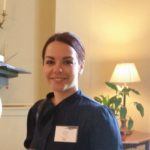Scottish research
Here are scientists related to this topic. Choose one to read about their work and ask them your questions.
-
Sylvia Soldatou

Current Job::
Research Scientist, University of Aberdeen
My latest work:
One of my recet projects involved the discovery of new molecules with antibiotic activity from fungi. We isolated those fungi from marine sponges that we collected in the Red Sea and from plants collected in Wadi El Natrun, a valley in Egypt. The idea behind that project was to use the isolated antibiotic molecules for textile functionalisation, tyring in that way to mimic the ancient Egyptians who were using local plants and herbs known for their anitbacterial properies when preparing the textiles to wrap the mummies.
-
Rebecca Shaw

Current Job::
PhD Student
My latest work:
I’ve been working on looking at the genes involved in the development of eyes 👀 and also looking at what genes are involved when things go wrong with eye development. Our eyes are so important and so it’s important to understand why sometimes they don’t work very well!
-
Ieva Cepaite

Current Job::
PhD Candidate
My latest work:
I’m currently trying to come up with Quantum Algorithms to improve solutions to so-called Partial Differential Equations which are very useful in many fields of Physics and Engineering (fluid-dynamics, electrodynamics, elasticity etc.).
Basically I’m trying to come up with new, better methods for old (but important) problems using the incredibly complicated way that Quantum Computers process information. It involves things like superposition and entanglement in order to improve speed or accuracy of solutions.
-
Liam Perera

Current Job::
PhD Student
My latest work:
Im interested in the Icy Moons of our solar system. Specifically Enceladus, a moon of Saturn, and Europa, a moon of Jupiter.
These moons are covered in thick icy crusts much like our rocky crust on Earth but made from ice. Beneath their crusts we think there are oceans of liquid water. It may be possible for simple, single-celled life to survive in these environments like Bacteria.
I look at how these microorganisms live within icy environments and how we may look for them if we sent a rover or lander mission to their surfaces.
-
Araceli Venegas-Gomez

Current Job::
I have always been interested in science since I was a child, and kept myself up to date with the latest scientific news. Some years ago I started to participate more actively in science discussions and conferences as a hobby.
I’m actually an aerospace engineer and science lover. After several years working in industry, I decided to follow my passion for science, and became a Physics PhD student! I like to think that I might discover new things about the universe at the quantum level. I love explaining complicated concepts and raising science awareness to the general public.
I fell in love with Quantum Mechanics. I wanted to learn more about it and found it so exciting that when I took the decision to quit my job in industry and go into research, I knew it had to be in that field.
There are just so many unanswered questions and unsolved mysteries about the universe we live in, both at a macro level and, in my case, at the tiniest level.I know, I’m a total science freak!
My latest work:
Many phenomena in the quantum world cannot be investigated directly in the laboratory, and even supercomputers fail at simulating them. Quantum simulators are specific purpose devices designed to provide insight on unique physics problems. I work with quantum simulators, using mathematical models to mimic the interactions of atoms in optical (light-made) lattices. With these investigations we can design specific magnetic properties or control matter to eventually create a quantum computer.
Behind all great technological advances in History there was a huge amount of theoretical work required to understand how things really work. To use a couple of examples, the GPS is based on the Einstein’s Theory of Relativity, and the laser invention relied on understanding the discrete nature of atomic energy levels (the quanta), which is the basis of Quantum Mechanics. Today, lasers are surrounding us and are key part of many commons tools we use daily! Quantum Physics studies the universe at the smallest level, and its applications are part of our daily life, in computers, magnetic resonance, lasers … Specifically in my work, we study quantum magnetism, directly linked to high temperature superconductors, leading to possible new materials in the future.
-
David Keeble

Current Job::
Professor, Head of Physics
My latest work:
One of our current projects is as part of a collaboration led by colleagues at National Institute of Advanced Industrial Science and Technology in Japan. It is an international collaboration performing positron lifetime measurements on the same series of well characterized materials that have nano-meter size open-volume (pores or voids) in a number of laboratories across the world. In the materials we are measuring some, in fact the majority, of the positrons we implant move into the nano-meter size open spaces, picking up an electron on the way, and forming what is called a positronium atoms. This is a electron bound to its anti-particle the positron. Those positronium atoms that form where the spins of the two particles are aligned would live for approximately 142 nanoseconds in a vacuum. This is a very long time to us as we typically measure lifetimes a thousand times smaller. However, these positronium atoms ‘bounce’ about inside the pore in the material and so annihilate typically after only a few nanoseconds. From the actual lifetime of the positronium we can calculate the approximate diameter of the pore. Materials scientists cannot easily measure pores/voids with nano-meter size. Our collaboration is aiming to produce standard samples and guidance on how to perform the measurements so that this method can be more widely used.
-
Vanesa Alvarez

Current Job::
Postdoctoral research assistant at University of Dundee
My latest work:
DNA replication is an essential process for the division of the cells. When we think about DNA replication, a double helix being duplicated comes to our minds. We always forget about the replication of the whole set of proteins that interacts with the DNA molecule. They have to be duplicated, too, and preserved in the same position they occupied in the mother DNA molecule. My current project is the study of how these proteins are conserved along the cell cycles.
-
Gerry McLachlan

Current Job::
Group Leader, The Roslin Institute
My latest work:
I work as part of the UK Cystic Fibrosis Gene Therapy Consortium and, as the name suggests, we’re trying to develop gene therapy for cystic fibrosis. The Consortium has been running for almost 20 years now. It is a collaboration between the University of Edinburgh, the University of Oxford and Imperial College London.
Within the Consortium, our team at Roslin is using sheep as a model to study gene delivery to the lung in people. We have been involved in a lot of preclinical testing of gene therapy vectors, which we then try to develop and optimise. Over the years, our gene therapy vectors have even gone as far as clinical trials in cystic fibrosis patients with some success.
In the past few years, we’ve been looking at using a new viral-based vector, giving us a very optimistic view for the future. This viral based vector, an SIV vector which can cause disease in primates, is similar to HIV. It is essentially the same kind of virus therefore it has to be modified to prevent it from being harmful.
We have been working on these viral-based methods for a while and it seems that they are more efficient than the non-viral systems used previously. The advantage of the viral mechanism is that SIV integrates into the genome of patients receiving treatment.
We’re quite optimistic and we’ve got funding in place from the Wellcome Trust and the Department of Health through the Health Innovations Challenge Fund that allows us to do clinical trial. We’ve also recently partnered up with a pharmaceutical company, which allows us to do a much more comprehensive program and hopefully get to clinic quicker. We really are quite optimistic for the future as this partnership may really provide us with a lot more resources, which we really need to be able to make this a viable treatment for patients.
https://www.research.ed.ac.uk/portal/en/persons/gerry-mclachlan(fca5cb60-7bf8-4ac4-a6e1-f8c170025c40).html
